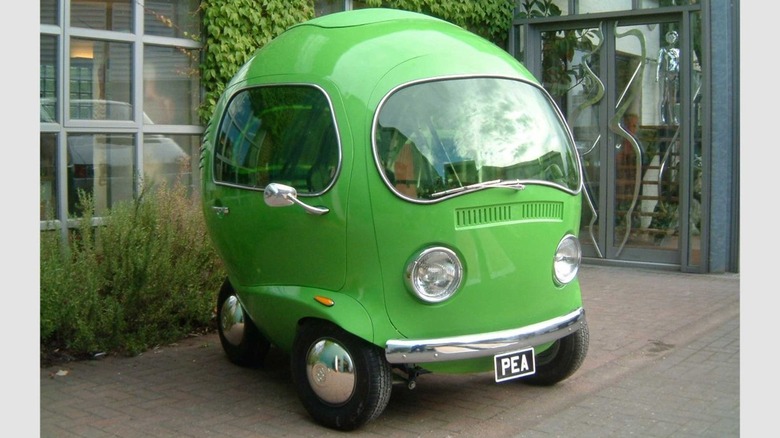Here's What Happened To The Infamous 'Pea Car'
Companies go to great lengths and spend a lot of money on advertising. Virtually nothing is off limits, including the zaniest of promotional gimmickry. In the mid-1930s, long before there was television and the Internet, two food companies decided to create vehicles that could drive around and promote their food items directly to the masses.
The first appeared in 1935 when Planters unveiled the original peanut car (a.k.a. the NUTmobile) and used it to shuttle around its brand salesman. A year later, a 13-foot-long vehicle shaped like a hot dog began appearing in the streets of Chicago in hopes of fostering the sale of "German-style Wieners," and the Oscar Mayer Wienermobile drove into the public consciousness.
Those promotional efforts were so successful that both have become pop-culture icons and are still winding their way through the streets. There have been other attempts to mimic that popularity, like Hershey's parade-float-looking Kissmobile, The Goldfish Mobile, Red Bull's can-topped MINI Cooper, and of much, much lesser repute, the Birds Eye Pea Car.
If your reaction was something like, "Wait, the what?" you're not alone. In December 2005, a television commercial aired for American frozen food brand Birds Eye. It trumpeted that fresh vegetables kept losing vitamins after getting picked, but Birds Eye veggies didn't because they were frozen to lock in all that goodness.
This was nothing like two peas in a pod
The entire spot lasted only 30 seconds and shows parts of the pea peeling off as it drives down the road, representing the vitamins a pea loses over time. It was a stroke of marketing genius but is largely forgotten today.
The idea started with Matt Waller and Dave Monk, who worked at the advertising firm of Bartle Bogle Hegarty (BBH) in London. They, in turn, shared it with the lead creative team at Birds Eye, and the concept took off faster than a frozen pea shot from a child's nostril.
The job of building a car that would fall apart as it drove was awarded to Asylum Models & Effects in London, and a short six weeks later, a star — or at the very least, a star side dish — was born.
Asylum began designing the car using 3D modeling software and, after approval, started crafting the substructure of the body using bars to fashion a spherical shape that resembled a singular pea. This was slapped on top of a modified chassis from an off-road go-kart. The company then created twelve fiberglass body panels and painted them Pantone 396c bright green.
More than just vitamins inside this particular pea
For the longest time, urban legend held that the car was built atop some form of a Volkswagen. Still, the only parts taken from one (a Bug, to be precise) were the headlights, one of the coolest and most recognizable features of the Volkswagen Beetle. Interestingly, the turn signals were taken from a Lancia, but the side door mirrors were made to order.
The engine powering the roughly 1,653-pound pea was a single-geared Honda with a top speed of around 60 mph. Obviously, it was nowhere near street-legal, so the commercial was shot in the English countryside on a road closed down specifically for filming. Since it had no doors and because parts and pieces had to fall off in transit, the stunt driver sat in a special seat attached directly to the chassis, which was practically the only thing that didn't get tossed.
Once the commercial was finished filming, the one-person pea pod traveled to publicity and promotional events and even had a short stint at the National Motor Museum in the United Kingdom.

